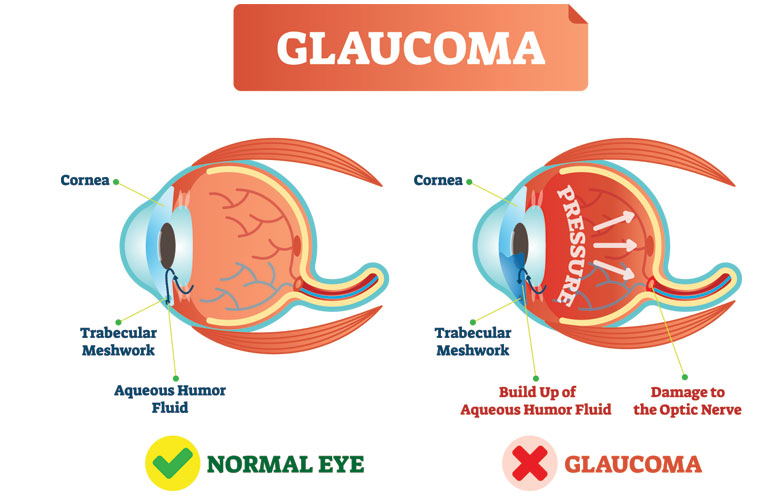
Over 80 million people in the world suffer from glaucoma. This optic-nerve-damaging disease is treatable if diagnosed early by a qualified eye specialist. Read on to know more about glaucoma, its risk factors, and treatment options:
What is glaucoma?
Through the optic nerve from the retina light, the signal is taken to the brain. It is a condition that affects this optic nerve, through the buildup of pressure inside the eye. If not managed timely, this raised pressure can cause permanent visual loss.
It only occurs when the pressure inside the eye rises due to blockage of fluid—called aqueous humor—inside the eye. This fluid nourishes the eye and usually flows out through a mesh-like channel. But if something blocks this channel, or if there is too much fluid buildup, the pressure inside the eye rises and compresses the optic nerve. Less commonly, severe eye infection, inflammatory conditions, and blocked blood vessels can cause glaucoma.
In the early phase of the disease, glaucoma can have no symptoms. For someone who gets regular eye examinations, glaucoma can be detected in the early phase, and treatment can be started before any lasting damage occurs.
This disease presents with variable symptoms, depending on the causative factors and the stage of the disease. For a type called angle-closure glaucoma, the symptoms are faster in onset and the damage can happen quickly. In this type of glaucoma, there is severe headache, redness, and eye ache with blurred vision and visual halos.
In open-angle, there are patchy spots in the central or peripheral vision that may advance to tunnel vision in the advanced stage. This is the most common type of glaucoma.
What are the risk factors of glaucoma?
- Age: people over the age of 40 years are at high risk.
- Ethnicity: Glaucoma incidence is higher in Asians and ethnicities like Japanese, Hispanic, and Scandinavian.
- Family history: This has a genetic predisposition and, in such cases, the regular ocular examination is a must.
- Poor vision: near or far-sighted people are at higher risk.
- Use of medication: you are linked to a higher risk of glaucoma if you use drugs like steroids, anti-epileptic drugs, bladder control drugs, and even some cold medications are linked to a higher risk of glaucoma.
- Eye injury: injury to the eye can block the trabecular meshwork from which aqueous humor flows. This can predispose the patient to glaucoma.
- Corneal thickness: people with thinner than normal corneas are at higher risk.
- Pigmentation: if the pigment from the iris (colored part of the eye) gets into the fluid inside the eyes, it can clog the drainage canals and lead to glaucoma.
- Other diseases: In some cases, glaucoma is linked to other illnesses like cataracts and uncontrolled diabetes. Both these conditions can lead to rising intraocular pressure and glaucoma. In addition, glaucoma can be secondary to sickle cell anemia, heart disease, and hypertension.
What are the treatment options?
Well, This has to be treated accordingly to its type. The mainstay of treatment is oral medication, eye drops, and laser surgery.
Eye drops:
Can be used to lower the formation of aqueous humor or increase its outflow from the eye. As these eyedrops are absorbed from the eye into the bloodstream, systemic side effects may be seen.
Oral medication:
Such as carbonic anhydrase inhibitor may be prescribed to lower the eye pressure if the eye drops alone are insufficient. The possible side-effects of this drug include depression, stomach upset, kidney stone, and frequent urination.
Laser therapy:
It is also called trabeculoplasty is performed for open-angle type. A small laser beam is used to open up clogged channels in the trabecular meshwork to drain the aqueous humor. This surgery takes a few weeks to show improvement.
Minimally invasive glaucoma surgery (MIGS):
This requires less post-operative care and has less risk than other surgeries. Commonly, it is combined with cataract surgery by healthcare providers like Best Eye specialists in Karachi. There are many types of MIGS, and the best one is chosen based on the patient profile.


